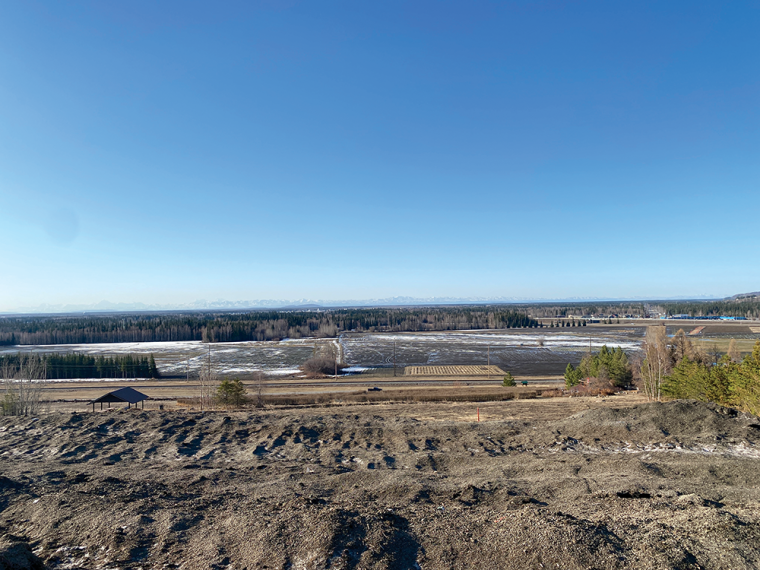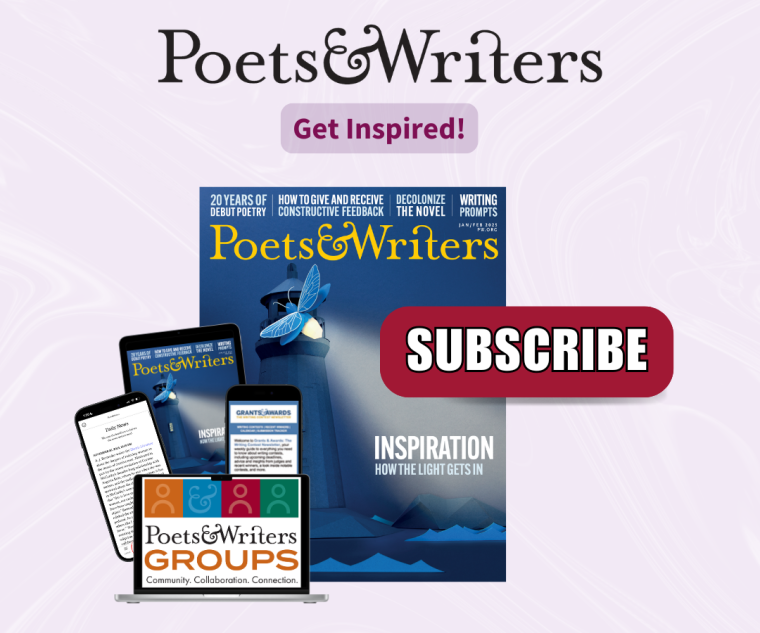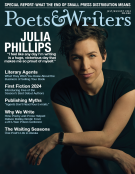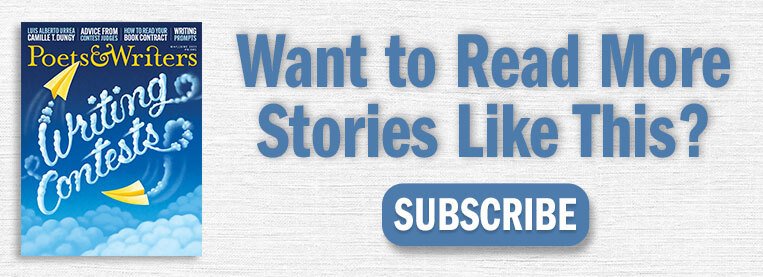When you come to Fairbanks, Alaska, visit the waste transfer sites. Fairbanks has several, each with a similar layout: large open lots located near main roads. This time of year, you won’t see them from the roadway. They’re surrounded first by chain-link fences and then obscured by the extravagant foliage of the birch, willow, aspen, and spruce trees. Almost every household outside of the city limits hauls its own waste. My husband usually drops off the trash on his way into town before work. There’s no leaving it in his truck bed and waiting until evening; the ravens would root through the bags and leave a terrible mess behind.

A view of the Tanana Valley and the last remnants of shoulder-season breakup from the West Ridge parking lot at the University of Alaska in Fairbanks.
But this August morning I’ll take the trash instead. I need to drive to town anyway, to use the internet. Scribner, an imprint of Simon & Schuster, is opening its submission portal to unagented poetry manuscripts and will cap entries at three hundred submissions. There’s no way my home internet can upload my manuscript in a timely manner. On a good day, our DSL connection achieves a 2.5 Mbps download and 0.7 Mbps upload speed. Today is not a good internet day. Using my cell phone as a hot spot isn’t an option either.
I live a few miles outside of Fairbanks proper, on top of a hill. Our home is surrounded by boreal forest, squirrels, chickadees, and sometimes moose. It’s also at the heart of a cell service dead zone. At home I text and call over Wi-Fi. When that’s not possible, I can send a text from the bottom of my driveway. If I walk a little farther, onto the dirt road that leads to our home, I can receive the GIFs my friend sends in reply. The location is idyllic if not always practical. The state of Alaska recently released a digital equity plan to rectify disparities in internet access across the state with a project time frame of 2023 to 2030. Until completed, the larger world remains less accessible.
I know, mostly via tweets, that more than three hundred other poets will try to submit to Scribner today. My friend Asa, who is wiser about these things than I am, suggested I have a cover letter and bio prepared in Word to copy and paste into the submission fields. Before I leave home, I open and resize my documents and web browser so both documents and browser are visible onscreen at the same time. There will be no fumbling while trying to copy and paste my bio and cover letter into the web form. Closing my laptop, I reassure myself that the only thing I have left to do is find somewhere I can connect to the internet, as everything is organized and ready to upload. Doing so, I feel foolish, the same way I feel when buying technical sportswear despite knowing that I’ll wear it only while walking and napping. But I’ll accept feeling foolish in exchange for feeling overprepared.
At the entrance of the transfer site is a reuse area: a series of folding tables and abandoned furniture that’s sometimes screened by a tarp. People leave behind items here that still have life left in them. Single-use grocery bags stuffed with clothes rest on top of overturned boxes. A lamp sits next to a folding chair and reflects the sunlight. The Shrimp Truck Man will sometimes park next to the reuse area and set up shop. He’ll place hinged signs that face the road and advertise Kodiak Scallops and Alaska Shrimp. He appears on his own timetable. I like the mystery of it, but I’m disappointed he isn’t here today.
I leave my kids’ outgrown clothes, folded and stacked like an offering, on an elementary-school desk, then creep my vehicle a few feet forward toward an empty dumpster, where I wrestle an overstuffed Glad bag into the bin. Once I’ve sanitized my hands, I’ve decided it’s too late to chance driving to a coffee shop for Wi-Fi. I have enough bars here to use my phone as a hot spot. I move to the far side of the lot and balance my laptop on my knees. A raven lands on the gravel in front of my car and watches me from the corner of their eye. They fluff their throat feathers, or hackles, in a rolling and puffing movement. Afterward they hop away to chase an errant wrapper.
What worries me is this: The trash bags, ravens, and fences aren’t enough to keep every wrapper contained. Nor is the reuse station enough to ensure all the still-useful items remain purposeful. In late summer, when fireweed blooms along the highways and the tall stalks and long leaves conceal debris that has escaped, it’s easy to forget this. And in winter, when snow crusts the litter in a white sheet, it’s unseeable. The images of brilliant summer wildflowers and severe winter landscapes are the images of Fairbanks that are accessible to most people. For most non-Alaskans, the images of Fairbanks and other parts of Alaska on the road system are familiar from encounters shaped by the window of a vehicle during the tourist seasons. What worries me is that those images, and the ones related to them, are also what populate much of Alaska-themed literature.
My worry is a selfish thing. As a writer living in Fairbanks who often writes about her homeplace, I’m aware of the incongruity between the landscapes I dwell within and the Alaskan landscapes I read about. Worst of all, I feel the tension within myself to perform a narrow, affirmative version of Alaska for an audience that I imagine desires an endless stream of poems and stories filled with people finding catharsis in the pristine wilderness.
But my most immediate worry on August 1, 2023, is that the time for the portal to open has come, but the page refuses to load. I press Command + R over and over, finally the page appears, and I upload my information. After I hit Submit I want a parade or a medal, but I settle for texting my poet friends to see who else caught the portal in time. Then I try to forget that I sent off my manuscript, so it’ll be easier to wait for a reply. The raven succeeds in wrestling the wrapper away from the wind. They hop a few steps sideways and fly away to perch in a spruce tree on the opposite side of the fence.
Alaska’s shoulder seasons are less photogenic. First, there’s breakup, which is like the end of cuffing season but with the addition of intermittent snow, slush, and a decadent amount of mud. It begins in mid-April and ends with greenup, the dramatic moment in early May when the trees unfurl their leaves in a delicious green haze. Then, in September and October, the fallen leaves decay into a brown mat that waits for snowfall’s cover. It’s easier during the shoulder seasons to see how permeable the boundaries are between the transfer sites and the rest of the borough. Silver-foiled juice pouches and aluminum cans flash against the brown ground. It isn’t for a lack of trying to enforce the border between litter and landscape; in May, Fairbanksians participate in the Golden Heart Clean Up Day, when the city folks don neon-yellow safety vests and comb the highways while carrying large green and yellow bags to corral the litter that escaped the first time we attempted to contain it. We leave the carefully knotted bags on the meridians at intersections, and Heavy Hauler volunteers transport the bags to the landfill.
More than winter even, I think of shoulder seasons as waiting seasons. Not stasis, but close to it. As periods marked not by time but by the aching anticipation of change, of the transformation from mud to the first wild strawberry leaves, or from bare-limbed trees to hoarfrost-encased branches backdropped by twilight blue sky. Perhaps that’s why the Alaska on screen and in literature glosses over shoulder seasons and reifies other images instead. Purple mountains looming over impossibly clear waters, a whale’s arced body hovering over a bay, the aurora borealis and the moon. These images are nicer scenes to project ourselves into. They fit neatly into a mental index of both beautiful and comfortably recognized other. Besides, it’s easier to imagine an inner revelation is at hand when there are birds nesting nearby.
I liked three things about Scribner’s submission process. First, it was free. Second, despite the different ways that a capped and online submission process impedes accessibility, I respect that Scribner sought to lower publishing hurdles for—three hundred, internet-accessing, flexible-scheduled—unagented poets. Finally, I appreciated that the publisher gave a firm end-of-year deadline for acceptances and rejections. At my core, I am not patient. I try to disguise this with mindfulness exercises and good manners, but not-so-deep-down inside, waiting leaves me in distress. Summer slows and fall begins. At least twice a day I drive past the transfer site while taking my children to and from school. I can’t always see it from the main road, but I can see its traces and hear the ravens gurgling.
The thing that shoulder seasons make uncomfortably clear is that away doesn’t exist. You may throw away your trash, but the barriers between trash, home, and the more-than-human world are porous. Or you might go away on vacation, but you will bring yourself back with you. At some point a raven will puncture the bag and render it into something less than a filter. What was cast away will, like salmon, migrate home.
Even though away is imaginary, it poses a real problem for Alaskan writers and for Alaskan readers hoping to find their home depicted upon the page. When an Alaskan landscape is imagined only as something isolated—as a place apart from—that imagining leaves little room for the reality of the relationships between place and the people who belong to it. Or, to be blunt, many stories and poems that are set in Alaska look like this: A person spends time in the Alaskan wilderness and the encounter with pristine nature changes them and/or reveals an essential truth about them. In these texts, Alaska exists only inasmuch as it furthers the protagonist’s movement toward personal triumph. Land and animal and plant kin are demoted to dramatic background to heighten the audience’s perception of the protagonist’s emotional arc.
The problem is there’s no room for a transfer site to exist in this image. And if there isn’t space for a transfer site and its attendant baggage, there’s no room for depictions of the messy community members who rely on transfer sites to hold their take-out containers and junk mail. The Alaska without a transfer site seems related to the colonial construct of Alaska as frontier, with images that rely on a settler moving from geographical areas marked by population and culture into areas of uninhabited wilderness. The problem, of course, is that the land has always been inhabited. Since time immemorial the Indigenous peoples of Alaska and the more-than-human world have been present and continue to share presence with each other here. More recently, Alaska’s animated and vibrant landscape contains an increasingly diverse population marked by complex relationships between place and its environments, ecologies, and beings.
It’s late December when I receive my rejection letter from Scribner. Sometimes being a writer in Fairbanks is exactly like being a writer elsewhere. I was visiting my in-laws when it arrived at top-internet speed, delivered directly to my phone. And since I was in Ohio, not only did it arrive at the same moment as the messages my friends and fellow submitting poets received, but we were all in the same time zone, and our daily rhythms were attuned to one another. It sounds so small on the page to tell you that I sat down with a cup of coffee mid-morning and texted a friend who texted back while drinking her mid-morning tea. But in my mind, the image of those texts between us is larger, the frame expanding to contain the two of us sitting on a couch, both of our heads bent over our e-mails, laughing and disappointed at the same time.
Annie Wenstrup is a Dena’ina writer. She was an inaugural and returning Indigenous Nations Poet (In-Na-Po) fellow and now serves as In-Na-Po’s Alumni and Donor Relations Coordinator. Her first poetry collection, The Museum of Unnatural Histories, is forthcoming in spring 2025 from Wesleyan University Press.
Resources for Writers in Alaska
Conferences & Residencies
Alaska Book Week, a statewide celebration, coordinated by Alaska Center for the Book, that includes readings, panels, lectures, and discussions around the first week in October.
Alderworks Alaska Writers and Artists Retreat, a residency on the banks of West Creek in Dyea for writers and artists alike.
Chulitna Lodge Creative Residency Program, a retreat on the shores of Lake Clark National Park that includes three possible forms of participation: as a fellow, a resident artist, or an honorary resident.
Kachemak Bay Writers’ Conference, a writers conference held at the Kenai Peninsula College campus in Homer featuring craft classes and conversations, readings, panels, and individual consultations for poets, fiction writers, and creative nonfiction writers.
North Words Writers Symposium, an annual gathering including panel discussions, workshops, faculty consultations, readings, and various outdoor activities held on the ancestral land of the Lkoot peoples in Skagway.
Storyknife Writers Retreat, two- to four-week residencies from April to October held on ten acres of wilderness overlooking the Aleutian Range outside of Homer, open to women poets and prose writers.
Tutka Bay Writers Retreat, an annual event sponsored by 49 Writers that includes an intimate writers workshop (open to poets, fiction writers, nonfiction writers, and translators) and outdoor activities at Tutka Bay Lodge near Homer.
Voices of the Wilderness Artist in Residence Program, one- to two-week residencies from June through August offered by the U.S. Forest Service, the National Park Service, and the U.S. Fish & Wildlife Service, open to poets and prose writers who wish to take part in stewardship projects in the wilderness of Alaska.
Funding Opportunities
Alaska Arts & Culture Foundation, a nonprofit and educational organization that manages four funds in support of the arts and provides resources and services for artists in state.
Alaska State Council on the Arts, an organization that “represents, supports, and advances the creative endeavors of individuals, organizations, and agencies throughout Alaska.”
Lin Halterman Memorial Grant, a monetary award given to Alaska Writers Guild members who apply and are in need of financial assistance for their writerly pursuits.
Select Independent Bookstores
Black Birch Books, a female, disabled, and veteran owned bookstore in Wasilla that hires homeless youth and binds books.
Dreamland Books & Yarn, a newly opened independent bookstore and yarn store in Seward, run by the same people who operate Resurrect Art Coffee House.
Fireside Books, a bookstore located in the heart of downtown Palmer that hosts book clubs, has a literary map of the state on their website, and engages in a Banned Book Giveaway for Matanuska-Susitna Borough students.
Forget-Me-Not Books, a used bookstore in Fairbanks, part of the Literacy Council of Alaska.
Hearthside Books, a local independent bookseller with two locations in Juneau that sells new books.
Homer Bookstore, the oldest independent bookstore on the Kenai Peninsula.
The Islander Bookshop, an independent and community-inspired bookstore in Kodiak, on the traditional homeland of the Alutiiq/Sugpiaq people.
Old Harbor Books, a bookstore founded in 1976 by a group of three book-loving local families, located in Sitka.
Old Inlet Bookshop, a family-owned bookstore run by third-generation booksellers that focuses on used, rare, and out-of-print books, operating in Homer since 1997.
Rainy Retreat Books, a bookstore located in Juneau selling new, used, and rare books.
River City Books, an independent bookstore established in 1999 and located in Soldotna.
Skaguay News Depot & Books, an independent bookstore in Skagway featuring a large selection of Alaska-Yukon books, journals, magazines, and more.
Libraries
Alaska State Library, the main library for the state, includes online resources to find the many public libraries in Alaska.
Writing Contests
Alaska Literary Awards, annual contests across all genres that include $5,000 cash prizes.
Permafrost Book Prize, a literary award given for a book of poetry, fiction, or nonfiction in alternating years, including a $1,000 cash prize and publication by the University of Alaska Press.
Literary Magazines
Alaska Quarterly Review, a biannual print and online magazine—“one of America’s premier” reviews—that represents a diverse range of emerging and established authors.
Cirque, a literary journal published in Anchorage with the intention of sharing the best writing in the North Pacific Rim region with the rest of the world.
Permafrost Magazine, America’s farthest north literary journal for writing and visual art, housed at the University of Alaska in Fairbanks English department and run by their creative writing graduate students.
Literary Organizations
49 Writers, “a vibrant community of diverse Alaskan writers” who host various programs such as public events, classes and workshops, retreats, and more in a variety of venues and communities throughout the state.
Alaska Center for the Book, a nonprofit organization that seeks “to stimulate public interest in literacy through the spoken and written word,” through various projects such as Alaska Reads, Alaska Book Week, a creative writing contest, and more.
Alaska Writers Guild, an organization that supports “published and unpublished writers at all skill levels in the state of Alaska,” with services that include an annual writers conference, workshops, a writing contest, and the Lin Halterman Memorial Grant.
The Island Institute, an organization based in Sitka that offers varied programming, including Sitka Story Lab for children and teenagers and a Resident Fellows Program for writers.
Select MFA Program
University of Alaska in Fairbanks, a three-year, full-time creative writing program established in 1965 that is open to poets, fiction writers, and creative nonfiction writers.








